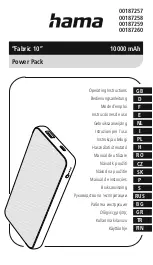
Page 4
For technical questions, please call 1-888-866-5797.
Item 57319
8.
Do not expose a battery pack or power tool to
fire or excessive temperature.
Exposure to fire or
temperature above 265°F may cause explosion.
9.
Follow all charging instructions and do
not charge the battery pack or power tool
outside of the temperature range specified
in the instructions.
Charging improperly or at
temperatures outside of the specified range may
damage the battery and increase the risk of fire.
10.
Have servicing performed by a qualified
repair person using only identical
replacement parts.
This will ensure that
the safety of the product is maintained.
11.
Do not modify or attempt to repair the power
tool or the battery pack except as indicated
in the instructions for use and care.
12.
The battery Charger gets hot during
use. The Charger’s heat can build
up to unsafe levels and create a fire
hazard if it does not receive adequate
ventilation, due to an electrical fault, or if it is used
in a hot environment. Do not place the Charger
on a flammable surface. Do not obstruct any
vents on the Charger.
Especially avoid placing
the Charger on carpets and rugs; they are not
only flammable, but they also obstruct vents
under the Charger.
Place the Charger on a
stable, solid, nonflammable surface (such as a
stable metal workbench or concrete floor) at least
1 foot away from all flammable objects, such as
drapes or walls. Keep a fire extinguisher and a
smoke detector in the area. Frequently monitor
the Charger and Battery Pack while charging.
Lithium Battery Safety Warnings
LITHIUM BATTERIES
STORE A LARGE AMOUNT
OF ENERGY AND WILL
VENT FIRE OR EXPLODE IF MISTREATED:
1.
Keep Battery Pack dry.
2.
DO NOT DO ANY OF THE FOLLOWING
TO THE BATTERY PACK:
•
Open,
•
Drop,
•
Short-circuit,
•
Puncture,
•
Incinerate, or
•
Expose to temperatures greater than 140°F.
3. Charge Battery Pack only according to instructions.
4. Inspect Battery Pack before every use;
do not use or charge if damaged.
Vibration Safety
This tool vibrates during use. Repeated or long-term
exposure to vibration may cause temporary or permanent
physical injury, particularly to the hands, arms and
shoulders. To reduce the risk of vibration-related injury:
1. Anyone using vibrating tools regularly or for an
extended period should first be examined by a
doctor and then have regular medical check-ups
to ensure medical problems are not being caused
or worsened from use. Pregnant women or
people who have impaired blood circulation to
the hand, past hand injuries, nervous system
disorders, diabetes, or Raynaud’s Disease should
not use this tool. If you feel any medical or
physical symptoms related to vibration (such as
tingling, numbness, and white or blue fingers),
seek medical advice as soon as possible.
2. Do not smoke during use. Nicotine reduces
the blood supply to the hands and fingers,
increasing the risk of vibration-related injury.
3. Wear suitable gloves to reduce the
vibration effects on the user.
4. Use tools with the lowest vibration when there
is a choice between different processes.
5. Include vibration-free periods each day of work.
6. Grip tool as lightly as possible (while still keeping
safe control of it). Let the tool do the work.
7. To reduce vibration, maintain the tool as
explained in this manual. If any abnormal
vibration occurs, stop use immediately.
SAVE THESE
INSTRUCTIONS.
GROUNDING
TO PREVENT ELECTRIC SHOCK AND
DEATH FROM
INCORRECT GROUNDING:
Check with a qualified electrician if you
are in doubt as to whether the outlet is properly
grounded. Do not modify the power cord plug
provided with the tool. Never remove the grounding
prong from the plug. Do not use the tool if the
power cord or plug is damaged. If damaged, have it
repaired by a service facility before use. If the plug
will not fit the outlet, have a proper outlet installed
by a qualified electrician.






























